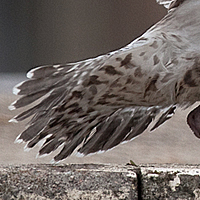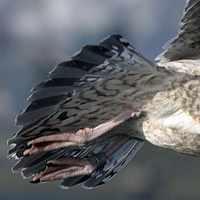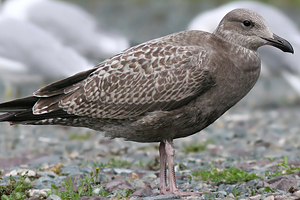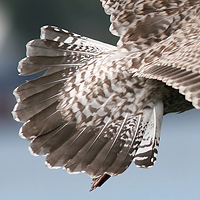 American Herring Gull (smithsonianus)
American Herring Gull (smithsonianus)
(last update: October 30, 2015)
American Herring Gull 1cy September
The issue of Dutch Birding 26: 1-35, 2004 contained a very comprehensive paper on the identification of smithsonianus, titled: Identification of American Herring Gull in a western European context. It was written by Pat Lonergan & Killian Mullarney. The outstanding text is copied on this webpage, with links now added to various Canadian birds photographed throughout the months. When appropriate, more details from recent field research has been added as well. Full PDF download: HERE.
"we" in the text below refers to the original authors.
If any errors occur in this text, please let me know and mail to marsmuusseatgmaildotcom.
Identification of American Herring Gull in a western European context
- Pat Lonergan & Killian Mullarney -

Larus argentatus argenteus juvenile tail pattern from below. July 30 2014, The Netherlands (Mars Muusse).
Identification of juvenile plumage
There is wide variation in the appearance of juvenile smithsonianus, from the most distinctive type (c 60%) which is very dark and practically uniformly textured on the underparts (plate 1), to less striking birds which have more mottled, or even pale-streaked, underparts and which could easily escape detection among a flock of large gulls in Europe. In addition to this variation which can be seen in Atlantic coast populations at, for instance, Cape May, New Jersey, in September, there appears to be another ’type’ of smithsonianus which deserves particular attention. Unfortunately, we have virtually no first-hand experience with what Howell et al (1999) referred to as ’Pacific coast [American] Herring Gulls’ which are presumed to originate from high-latitude populations and apparently perform a long-distance migration to winter mostly in California. Judging from a few published photographs (eg figures 1, 6 and 10 in Howell 2001) and some of the American Herring Gull videoclips featured in The large gulls of North America (Dunn et al 1997), the birds that winter in west
North America include a much higher proportion of what might be described as ’problematic' first-years than we observed on the east coast. Possibly the closest thing to a ’high-latitude'-type smithsonianus we have seen on this side of the Atlantic is a bird, still in full juvenile plumage, at Cobh, Cork, Ireland in January 2001 (Diggin 2001). It was one of three birds identified as smithsonianus present at Cobh that winter and caused quite a bit of debate when it was first observed due to its rather streaked underparts and overall similarity to some argentatus types. David Sibley examined images of this bird and commented that, when he was based at Cape May, New Jersey, he would see a very small number of similar-looking birds but that they did not appear there before November. The late arrival of these birds and their tendency to retain juvenile plumage well into the winter suggests a northerly origin. Interestingly, we did not find any that were clearly of this type in Massachusetts in January-February; David Sibley (pers comm) considers this type to be much more frequent in California than anywhere in eastern North America.
Apart from the Cobb juvenile, and another juvenile in Galway in December 2000, all of the smithsonianus we have studied in Ireland have corresponded well with the more distinctive ’Atlantic coast type' we are familiar with through observations in New Jersey and Massachusetts (plate 27). At the risk of exaggerating a problem which we have not had the opportunity to fully investigate ourselves (due to the absence of so-called 'high-latitude'-type smithsonianus in the parts of North America we have visited), we recommend particular caution be exercised when identifying juvenile smithsonianus in Europe. We have noticed a disturbing similarity between several putative smithsonianus photographed in Europe, including the Cobh juvenile,
and some perplexing first-year herring gulls, possibly hybrids, observed in Iceland in March
2003.
Having said that, we suggest that critical assessment of the following characters should help
resolve the identification of any suspected juvenile smithsonianus in Europe.
Tail pattern An ’all-dark' tail is popularly regarded as the most essential attribute of any candidate first-year smithsonianus in Europe and birds possessing one are usually among the most easily identified individuals. Three things must be emphasized here however:
1 only a minority of first-year smithsonianus really do have what might justifiably be described as an ’all-dark’ tail;
2 an absolutely all-dark tail (including the outer webs of the outermost rectrices) has been observed in first-year European Herring Gulls;
3 the difficulty in establishing the exact tail pattern in the field, as opposed to from critical examination of good photographs, is often underestimated. Many smithsonianus have an extent of dark on the tail that is very rarely matched by European Herring. Those with the most extensively dark tails
have a solid-dark upper tail surface, as viewed from above (plate 33, figure 1), the only relief being the pale shaft-bases. Close examination will often reveal a very narrow strip, barred black and white, along the outermost edge to the tail (plate 3, figure l) and it is not unusual for there to be some limited pale barring or vermiculation on the bases to the outer two or three pairs of rectrices. ln addition, the fully spread tail (best looked for as a bird takes off or just before it alights), or a view of the tail from below, will often reveal quite extensive areas of pale barring or vermiculation on the bases to the inner webs of the outer rectrices. The variety of tail patterns featured in figure 1 clearly illustrate the point that an ’all-dark' tail should not necessarily be considered a prerequisite of smithsonianus. Some European Herring Gulls can show a tail pattern approaching that of classic smithsonianus but only exceptionally are the outer rectrices wholly dark (Peter Adriaens pers comm). Similarly, it is not exceptional for smithsonianus to have extensive white (usually barred dark) at the base to the outer rectrices and it may even be that this variation is more frequent in some populations than in others.
Vent and undertail-coverts The ventral area and undertail-coverts of juvenile smithsonianus are generally more densely patterned with dark than in European Herring Gull, in which these areas are sparsely marked and usually appear predominantly whitish. 'Classic' smithsonianus are so extensively dark on the undertail-coverts that the white 'bars' may be reduced to little more than paired spots, and the longest undertail-coverts may be almost solidly dark-centred; such bold and extensive dark markings are probably never shown by European Herring, although a few are more heavily marked than usual and may resemble smithsonianus. Of course, some smithsonianus are not so heavily marked on the undertail-coverts but such birds are very much in a minority in North America, at least in Atlantic seaboard populations. Any suspected juvenile smithsonianus in Europe which does not exhibit reasonably dense or bold undertail-covert-markings should be considered very critically before being positively identified.
   |
   |
| FIGURE 2 Variation in vent and undertail pattern of first-winter American Herring Gull Larus smithsonianus. (top 3 images) and European Herring Gull L. argentatus (lower 3). |
Pattern of rump and uppertail-coverts In smithsonianus, the rump and uppertail-coverts are characteristically densely patterned with dark brown bars, chevrons or large spots, the overall tone being close to that of the rest of the upperparts but clearly contrasting with the often 'all-dark' tail (plate 3). The overall look of the tail and rump may prompt comparisons with that of a pale- or intermediate-morph juvenile Pomarine Jaeger Stercorarius pomarinus. On well-marked birds, this is a striking difference from any typical European Herring Gull but the degree of variation both ways means there is considerable overlap. The longest uppertail-coverts may have a completely dark centre - a pattern similar to that of the lower scapulars, and very probably not occurring in first-year European Herring.
  |
  |
| Uniformity of underparts in first-winter American Herring Gull Larus smithsonianus. |
Uniformity of underparts The strikingly smooth-textured, evenly dark underparts of many juvenile smithsonianus are probably never truly matched by European Herring Gulls. Sometimes, however, European birds are more evenly saturated and darker-looking below than usual, so care should be taken not to place too much importance on this feature alone.
Upperparts The pale fringes and notches to the upperpart-feathers average slightly less extensive than in European Herring Gull, contributing to an overall darker appearance. At the darker end of the range (plate 1), the patterns are probably never matched by juvenile European Herring but lighter smithsonianus could easily escape detection, at least on the basis of upperparts pattern, among their European counterparts.
Tertial pattern In juvenile plumage, the tertial pattern is rather similar to some graellsii (and therefore unlike most argenteus) with little notching which is generally ’finer’ and is usually confined to the tips of the feathers. Juvenile argentatus tertials are often even more extensively pale-notched than in argenteus but, significantly, a high proportion of Finnish argentatus, which might be described as ’dark type', have much reduced pale fringe-markings, their tertials being similarly patterned to graellsii.
Greater-covert bar Most smithsonianus show a variable amount of solid dark-brown at the base of the greater coverts which is clearly visible on the resting bird, forming an additional 'bar’ in flight (plate 33), similar to that shown by most first-year graellsii. The significance of this feature has, perhaps, been over-emphasized since it is by no means exclusive to smithsonianus and is often shown by argentatus and sometimes by argenteus.
Inner primaries On average, the inner-primary window of first- and second-year smithsonianus is slightly duller than in European Herring Gulls of the same age, adding to the uniformity of the upperwing. While there is usually no strong contrast between inner and outerwebs on these feathers in either smithsonianus or European Herring (thus differing from graellsii), the ground colour of the inner primaries is rather dull brownish grey in smithsonianus, while more pale greyish (with less of a muddy brown tinge) in European Herring Gull. This is not a terribly useful character, of course, but it may be of some significance in evaluating contentious birds.
Confusion with graellsii
There are many similarities between juvenile smithsonianus and dark first-year graellsii, some of which can show a confusing combination of rather dark underparts, heavily patterned rump and uppertail-coverts and sometimes an apparently ’all-dark’ tail. Most graellsii can, however, be quickly recognized by their more light-weight build, narrower, more pointed wings and slimmer bill than smithsonianus but, since not all smithsonianus are ’heavyweights’ (plate 5) and size is not always easily determined, the following characters should be checked:
Lack of pale window on inner primaries Much as in European Herring Gull, smithsonianus show a prominent pale window on the inner primaries. In graellsii, the inner primaries are almost as dark as the outer.
Uniformity of underparts Generally, never matched by graellsii but some of the latter are potentially confusing.
Vent and undertail-coverts The ventral area and undertail-coverts of juvenile smithsonianus are generally much more densely patterned than in graellsii.
Pattern of rump and uppertail-coverts Most graellsii show an obviously whitish rump contrasting with a black tail-band but a few show a pattern and density of markings that is undeniably close to that of less heavily marked smithsonianus. It is all-too-easy, when concentrating too much on this one feature, to overlook the other identification clues and mistake such dark graellsii for smithsonianus.
BACK TO: MOULT, STRUCTURE, DESCRIPTION
 |
| Lesser Black-backed Gull 1cy R:R1S September 30 2012, Landfill VRSU de Colmenar Viejo, Madrid, Spain. Picture: Delfín González. |
East Coast birds
 American Herring Gull (smithsonianus) 68A 1st cycle (1CY), September 06 2014, Stone Harbor, NJ. Picture: Jeff Loomis.
American Herring Gull (smithsonianus) 68A 1st cycle (1CY), September 06 2014, Stone Harbor, NJ. Picture: Jeff Loomis. American Herring Gull (smithsonianus) 62H 1st cycle (1CY-2CY), September 2015 - February 2016, Stratford, CT. Picture: Donna Caporaso & Patrick Comins.
American Herring Gull (smithsonianus) 62H 1st cycle (1CY-2CY), September 2015 - February 2016, Stratford, CT. Picture: Donna Caporaso & Patrick Comins. American Herring Gull (smithsonianus) 1st cycle (1CY) X65 September 28 2013, Hampton Beach, NH. Picture: Jon Worthen.
American Herring Gull (smithsonianus) 1st cycle (1CY) X65 September 28 2013, Hampton Beach, NH. Picture: Jon Worthen. American Herring Gull (smithsonianus) juvenile / 1st cycle Y49 September 13 2013, Hampton Beach, NH. Picture: Jon Worthen.
American Herring Gull (smithsonianus) juvenile / 1st cycle Y49 September 13 2013, Hampton Beach, NH. Picture: Jon Worthen. American Herring Gull (smithsonianus) juvenile / 1st cycle Y54 September 05 2013, Elizabeth, NJ. Picture: Anthony Chodan.
American Herring Gull (smithsonianus) juvenile / 1st cycle Y54 September 05 2013, Elizabeth, NJ. Picture: Anthony Chodan. American Herring Gull (smithsonianus) 1st cycle (1CY) Z23 August - September 2013, Jenness Beach & Hampton Beach, NH. Picture: Jon Worthen & Lauren Kras.
American Herring Gull (smithsonianus) 1st cycle (1CY) Z23 August - September 2013, Jenness Beach & Hampton Beach, NH. Picture: Jon Worthen & Lauren Kras. American Herring Gull (smithsonianus) 44H 1st-2nd cycle (1CY-2CY), September 2015 & 2016, Hampton Beach, NH. Picture: Jon Worthen & Leonard Lariviere.
American Herring Gull (smithsonianus) 44H 1st-2nd cycle (1CY-2CY), September 2015 & 2016, Hampton Beach, NH. Picture: Jon Worthen & Leonard Lariviere. American Herring Gull (smithsonianus) 1cy, September 22 2012, Plum Island, Massachusetts, USA. Picture: Suzanne Sullivan.
American Herring Gull (smithsonianus) 1cy, September 22 2012, Plum Island, Massachusetts, USA. Picture: Suzanne Sullivan. American Herring Gull (smithsonianus) 1cy, September 24 2012, New Hampshire coast, US. Picture: Laura Erickson.
American Herring Gull (smithsonianus) 1cy, September 24 2012, New Hampshire coast, US. Picture: Laura Erickson. American Herring Gull (smithsonianus) 1cy, September 09 2012, Plum Island, Massachusetts, USA. Picture: Suzanne Sullivan.
American Herring Gull (smithsonianus) 1cy, September 09 2012, Plum Island, Massachusetts, USA. Picture: Suzanne Sullivan. American Herring Gull (smithsonianus) 1st cycle (1CY), September 18 2011, Assateague Island National Seashore, Worcester Co., MD. Picture: Frode Jacobsen.
American Herring Gull (smithsonianus) 1st cycle (1CY), September 18 2011, Assateague Island National Seashore, Worcester Co., MD. Picture: Frode Jacobsen. American Herring Gull (smithsonianus) 1cy, September 01 2010, Portland, Maine. Picture: Heather Paul.
American Herring Gull (smithsonianus) 1cy, September 01 2010, Portland, Maine. Picture: Heather Paul. American Herring Gull (smithsonianus) 1cy, September 09 2007, Dartmouth, Nova Scotia, Canada. Picture: P.J. Gergely.
American Herring Gull (smithsonianus) 1cy, September 09 2007, Dartmouth, Nova Scotia, Canada. Picture: P.J. Gergely. American Herring Gull (smithsonianus) 1cy, September 22 2012, Plum Island, Massachusetts, USA. Picture: Suzanne Sullivan.
American Herring Gull (smithsonianus) 1cy, September 22 2012, Plum Island, Massachusetts, USA. Picture: Suzanne Sullivan. American Herring Gull (smithsonianus) 1cy, September 22 2012, Plum Island, Massachusetts, USA. Picture: Suzanne Sullivan.
American Herring Gull (smithsonianus) 1cy, September 22 2012, Plum Island, Massachusetts, USA. Picture: Suzanne Sullivan. American Herring Gull (smithsonianus) 1cy, September 09 2007, Dartmouth, Nova Scotia, Canada. Picture: P.J. Gergely.
American Herring Gull (smithsonianus) 1cy, September 09 2007, Dartmouth, Nova Scotia, Canada. Picture: P.J. Gergely. American Herring Gull (smithsonianus) juvenile / 1st cycle, September 04 2011, Madison, CT. Picture: Keith Mueller.
American Herring Gull (smithsonianus) juvenile / 1st cycle, September 04 2011, Madison, CT. Picture: Keith Mueller. American Herring Gull (smithsonianus) juvenile, September 08 2010, Monhegan Island, Maine, US. Picture: Keith Mueller.
American Herring Gull (smithsonianus) juvenile, September 08 2010, Monhegan Island, Maine, US. Picture: Keith Mueller. American Herring Gull (smithsonianus) 1st cycle (1CY), September 03 2013, Stratford, CT, USA. Picture: Donna Rae Henault Caporaso.
American Herring Gull (smithsonianus) 1st cycle (1CY), September 03 2013, Stratford, CT, USA. Picture: Donna Rae Henault Caporaso.







